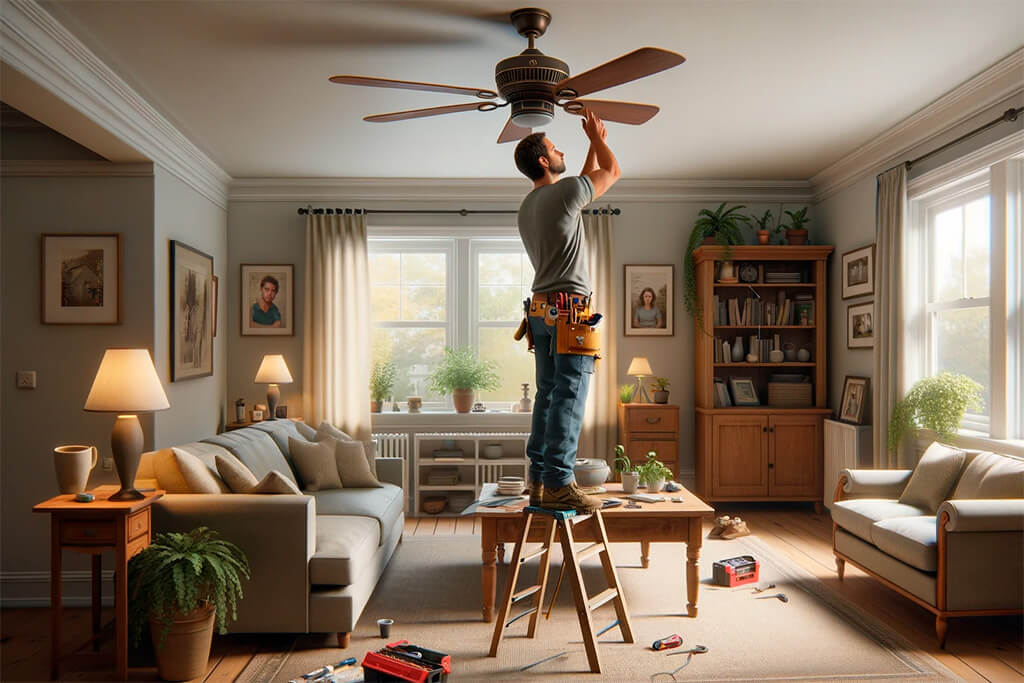When it comes to installing a ceiling fan box, precision and thoroughness are paramount. This task is not just about ensuring the fan runs smoothly, it’s fundamentally a safety issue. Electrical installations, especially those that support weight, demand careful attention to detail. My aim here is to guide both seasoned professionals and DIY enthusiasts through a reliable process, ensuring a secure and efficient installation.

Essential Tools and Materials
Firstly, let’s gather our tools. For this task, you’ll need:
- Screwdriver: Ideally, have both Phillips and flat-head types.
- Drill: Essential for creating pilot holes in tough spots.
- Stud Finder: A critical tool for locating joists accurately.
- Level: To ensure your fan box is perfectly horizontal.
- Wire Stripper: Necessary if you’re handling the wiring yourself.
As for the ceiling fan boxes, their selection depends on your ceiling type. You have the standard boxes for most ceilings, brace boxes for when a joist isn’t accessible, and pancake boxes for situations with limited space between the ceiling and the floor above.
Safety Precautions
Safety can’t be overstressed. Always start by turning off power at the circuit breaker to avoid any electrical hazards. Wear safety glasses and gloves to protect yourself. Keep your workspace orderly, a clutter-free area reduces the risk of accidents.

Step-by-Step Installation Guide
- Locating the Ceiling JoistUse your stud finder to detect the joists in your ceiling. Mark the edges and center of the joist clearly. This step ensures that your fan box will be supported adequately.
- Preparing the Ceiling Fan BoxChoose the appropriate fan box. Standard boxes are suitable for most situations, but in the absence of a joist, a brace box that can be expanded is ideal. Pancake boxes are the go-to for limited spaces. Prepare your box by attaching any necessary mounting brackets.
- Mounting the Box to the JoistAlign the box with the marked center of the joist. It’s crucial to drill pilot holes for the screws to avoid splitting the wood. Use a level to ensure the box is perfectly horizontal before securing it with screws.
- Wiring the Ceiling Fan BoxIf wiring is involved, strip the wires to the appropriate length. Connect them following standard color coding – black to black (hot), white to white (neutral), and green to ground. Always adhere to local electrical codes for safety compliance.
- Attaching the Ceiling FanFollow the manufacturer’s guidelines to attach the fan to the box. This step is crucial for achieving a balanced and stable installation. Test for any imbalance or noise and make adjustments as needed.

Troubleshooting Common Issues
In the world of renovation, encountering issues is par for the course, but knowing how to address them is what sets apart a successful project. Let’s look at some common challenges:
- Misaligned Holes: This is a frequent hurdle. If your screw holes are off-kilter, resist the urge to force things. Instead, take a step back, reevaluate your measurements, and if necessary, drill new pilot holes. Accuracy here is more than a virtue, it’s a necessity.
- Unstable Mounting: A shaky fan box is a clear sign of trouble. This often means your screws aren’t fully engaging with the joist. Remove them, check for wear or stripping, and replace them if needed. Remember, the right type and length of screw are crucial for a secure mount.
FAQ Section
When dealing with a heavier fan, selecting the right box is critical. Opt for a box specifically rated for heavier fixtures. These boxes are designed with robust mounting hardware and are built to provide a firm anchor in your joist or brace system.
Yes, but it requires a bit more finesse. You’ll need an angled mounting bracket to compensate for the slope and ensure the fan hangs level. Most ceiling fan kits include these brackets, but it’s always wise to confirm before beginning the installation.
The adequacy of electrical wiring is a common concern, especially in older homes. A key factor is the wire gauge, thinner wires may not safely handle the fan’s electrical load. When in doubt, it’s prudent to consult with a qualified electrician.
Direct attachment to a joist is ideal for optimal support. However, if this isn’t feasible, consider a fan-rated brace that can span between two joists, providing a sturdy foundation for your fan.
If your ceiling lacks an electrical box, you’ll need to install one. This involves cutting an appropriate-sized hole in the ceiling, routing the electrical wiring, and securing a brace or a heavy-duty remodel box that can firmly attach to the drywall.
